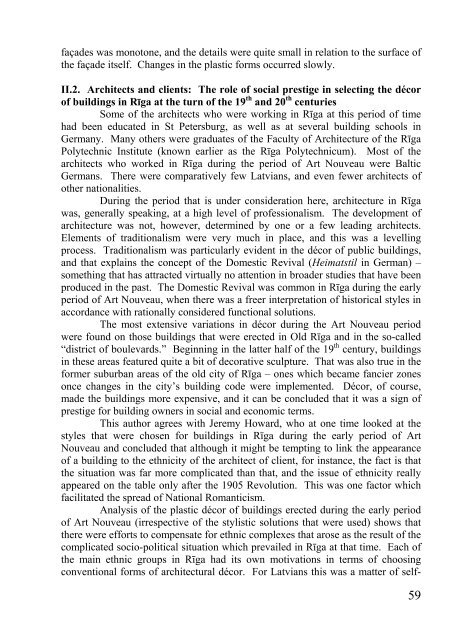SILVIJA GROSA JŪGENDSTILA PERIODA PLASTISKAIS UN ...
SILVIJA GROSA JŪGENDSTILA PERIODA PLASTISKAIS UN ...
SILVIJA GROSA JŪGENDSTILA PERIODA PLASTISKAIS UN ...
Create successful ePaper yourself
Turn your PDF publications into a flip-book with our unique Google optimized e-Paper software.
façades was monotone, and the details were quite small in relation to the surface of<br />
the façade itself. Changes in the plastic forms occurred slowly.<br />
II.2. Architects and clients: The role of social prestige in selecting the décor<br />
of buildings in Rīga at the turn of the 19 th and 20 th centuries<br />
Some of the architects who were working in Rīga at this period of time<br />
had been educated in St Petersburg, as well as at several building schools in<br />
Germany. Many others were graduates of the Faculty of Architecture of the Rīga<br />
Polytechnic Institute (known earlier as the Rīga Polytechnicum). Most of the<br />
architects who worked in Rīga during the period of Art Nouveau were Baltic<br />
Germans. There were comparatively few Latvians, and even fewer architects of<br />
other nationalities.<br />
During the period that is under consideration here, architecture in Rīga<br />
was, generally speaking, at a high level of professionalism. The development of<br />
architecture was not, however, determined by one or a few leading architects.<br />
Elements of traditionalism were very much in place, and this was a levelling<br />
process. Traditionalism was particularly evident in the décor of public buildings,<br />
and that explains the concept of the Domestic Revival (Heimatstil in German) –<br />
something that has attracted virtually no attention in broader studies that have been<br />
produced in the past. The Domestic Revival was common in Rīga during the early<br />
period of Art Nouveau, when there was a freer interpretation of historical styles in<br />
accordance with rationally considered functional solutions.<br />
The most extensive variations in décor during the Art Nouveau period<br />
were found on those buildings that were erected in Old Rīga and in the so-called<br />
“district of boulevards.” Beginning in the latter half of the 19 th century, buildings<br />
in these areas featured quite a bit of decorative sculpture. That was also true in the<br />
former suburban areas of the old city of Rīga – ones which became fancier zones<br />
once changes in the city’s building code were implemented. Décor, of course,<br />
made the buildings more expensive, and it can be concluded that it was a sign of<br />
prestige for building owners in social and economic terms.<br />
This author agrees with Jeremy Howard, who at one time looked at the<br />
styles that were chosen for buildings in Rīga during the early period of Art<br />
Nouveau and concluded that although it might be tempting to link the appearance<br />
of a building to the ethnicity of the architect of client, for instance, the fact is that<br />
the situation was far more complicated than that, and the issue of ethnicity really<br />
appeared on the table only after the 1905 Revolution. This was one factor which<br />
facilitated the spread of National Romanticism.<br />
Analysis of the plastic décor of buildings erected during the early period<br />
of Art Nouveau (irrespective of the stylistic solutions that were used) shows that<br />
there were efforts to compensate for ethnic complexes that arose as the result of the<br />
complicated socio-political situation which prevailed in Rīga at that time. Each of<br />
the main ethnic groups in Rīga had its own motivations in terms of choosing<br />
conventional forms of architectural décor. For Latvians this was a matter of self-<br />
59












